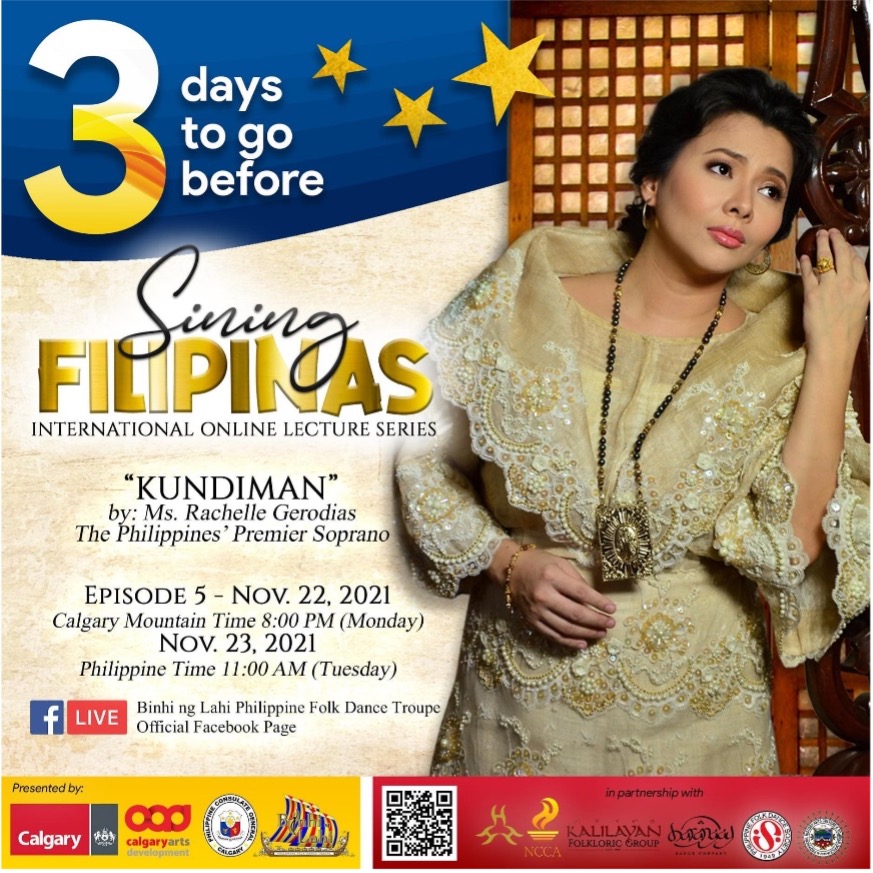
14 December 2021, Calgary – The Philippine Consulate General (PCG) in Calgary and Binhi ng Lahi Folk Dance Troupe have once again collaborated in bringing the fifth installment of the Sining Filipinas online lecture series with the offering of the “Kundiman” which premiered on 22 November 2021 on Binhi ng Lahi’s Facebook page and shared on the PCG’s Facebook page.
The episode, hosted by premier Filipina soprano Rachelle Gerodias-Park, informed the audience of what the kundiman is: a Filipino music cultural emblem that captures the Filipino’s soul. From its lowly beginning among the Tagalog to what is now referred as “classical kundiman,” this song form has evolved into “the “best expression of the Filipino spirit,” according to Atang dela Rama, the Reyna ng Kundiman.
Ms. Gerodias-Park gave the audience a knowledge-packed narrative on the origins and development of the kundiman. The photographs, old illustrations and portadas of published kundiman music scores were generously shown throughout the lecture. It included what is believed to be two of the earliest published kundiman music scores from Jose Honorato Lozano’s 1847 work “Album Vistas de las Yslas Filipinas y Trages de sus Abitantes.” Two samplings of kundiman songs, taken from the speaker’s kundiman record album, were also included for the audience’s appreciation.
A high point in the lecture was on how the kundiman evolved to suit the needs, and experiences of our people during specific periods of our nation’s history. The song form evolved – in the later part of the Spanish occupation to around much of the American era – into a love song which masks a more seriously-themed song for a lovely but distressed oriental mutya (“muse,” literally, a ‘gem’), a passing reference to the Motherland. From the popular works around 1920s-1930s like “Mutya ng Pasig,” “Nasaan Ka Irog?”, ”Kundiman ng Luha,” “Mutya ng Silangan,” and “Bayan Ko,” the kundiman was consistently employed in subtly delivering patriotic sentiments, often, a call to deliver the mutya from bondage.
The speaker then delved into the kundiman as an art song phase, as popularized by Atang dela Rama. Kundiman also naturally flowed to the cinema in the post-war era in what is referred to now as the “kundiman melodrama” where kundiman music “played an important role in enhancing the cinematic experience because it mimics the extra-musical meaning of mercy and hope (awa at pag-asa) signified through its melodic character, text, and tonality,” opines the speaker.
Ms. Gerodias-Park was both hopeful and truthful in her concluding statements on the future of the kundiman. Echoing the words of the late Philippine cultural studies pioneer Dr. Florentino Hornedo, the kundiman, just like any expression of our culture is “non-linear,” similar to the sapin-sapin, the famous Filipino rice cake with its colorful layers representing the coexistence of our people’s cultures from various eras. Like the kundiman, the classic or folksy exists somewhere even this time.
The Kundiman episode and previous episodes of the Sining Filipinas online lecture series can be viewed on the Facebook page of Binhi ng Lahi @BinhingLahi. They are:
a. Episode 1: Pagsalin–Urog Han Pasko: The many ways Filipino folks celebrate Christmas
b. Episode 2: The Philippine Rondalla: A distinct musical ensemble
c. Episode 3: Tubong of Catanauan: Practice & Tradition
d. Episode 4: Baybayin: An ancient script every Filipino must know
(Credit on the write-up: Mr. Aquino Irasga Jr. – Writer and Researcher)
